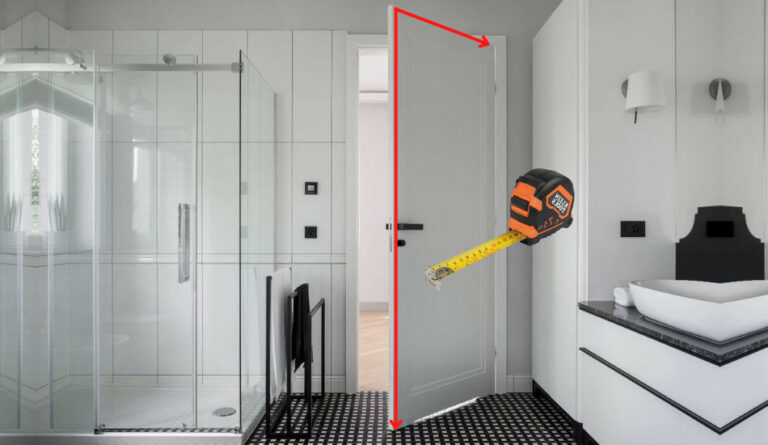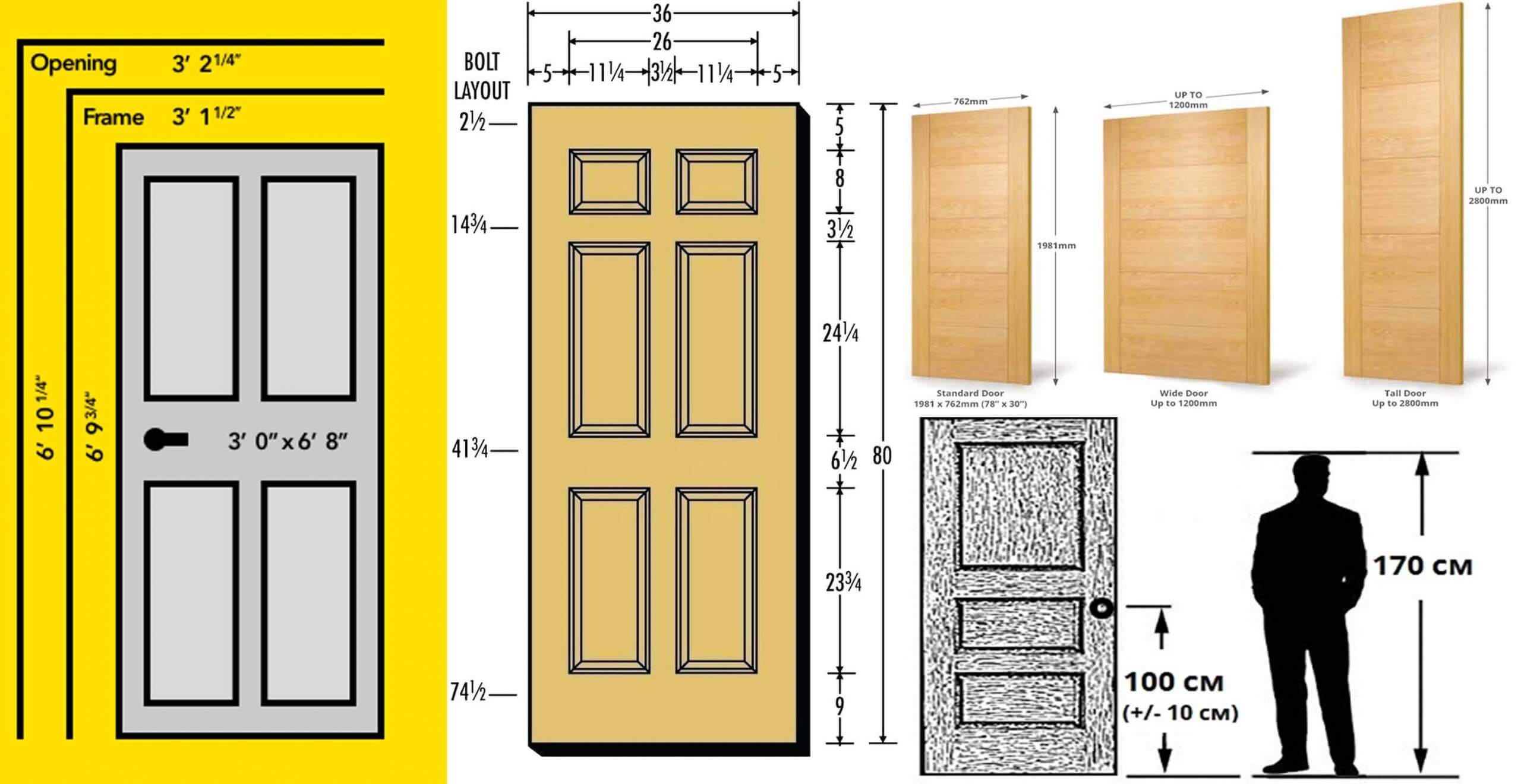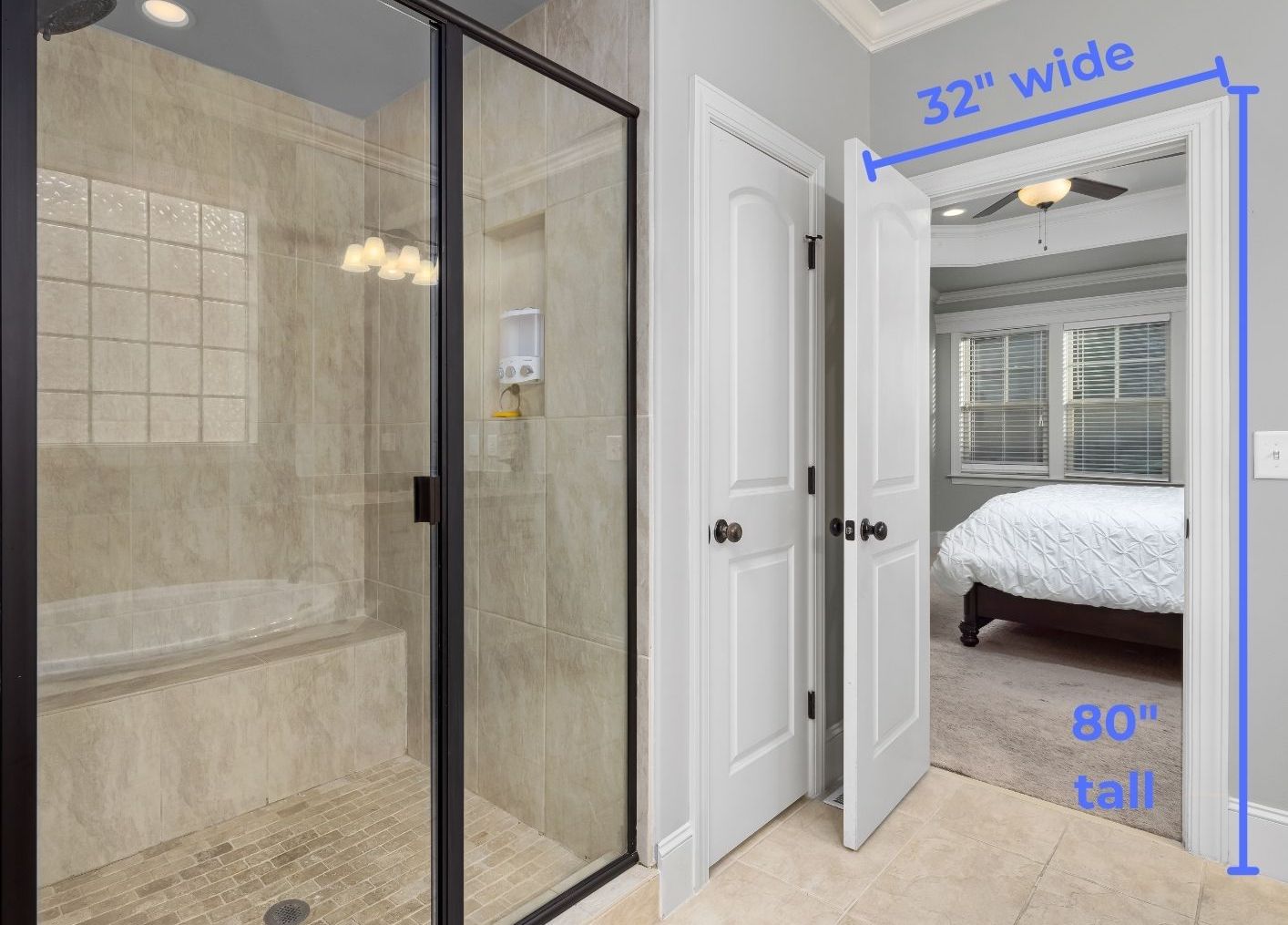Standard Bathroom Door Dimensions: Standard Width Of Bathroom Door

Choosing the right bathroom door size is crucial for both functionality and aesthetics. A well-sized door ensures easy access, comfortable movement, and a balanced look within the bathroom space. Standard bathroom door dimensions are established based on factors like accessibility guidelines, building codes, and typical bathroom layouts.
Standard Bathroom Door Widths
The standard width for a single bathroom door is 32 inches (81.28 cm). This width provides sufficient space for comfortable passage and allows for the placement of furniture like a toilet or vanity without obstruction. Here’s a table summarizing standard widths for various door types:
| Door Type | Width (inches) | Width (centimeters) |
|---|---|---|
| Single Door | 32 | 81.28 |
| Double Door | 64 | 162.56 |
| Pocket Door | 32 | 81.28 |
Factors Influencing Standard Door Widths
The standard dimensions are influenced by several factors:
- Accessibility Guidelines: The Americans with Disabilities Act (ADA) sets minimum width requirements for doorways to ensure accessibility for individuals with disabilities. The ADA recommends a minimum clear opening of 32 inches for doorways. This ensures that wheelchairs, walkers, and other mobility devices can pass through easily.
- Building Codes: Building codes, enforced by local authorities, dictate minimum door widths for various types of buildings, including residential homes. These codes aim to ensure safety and accessibility.
- Typical Bathroom Layouts: Standard bathroom layouts often feature a single door, typically 32 inches wide, to accommodate the common layout of a toilet, vanity, and shower/tub. This width is generally sufficient for most bathroom configurations.
Implications of Choosing Non-Standard Door Widths
While standard widths are generally recommended, there are instances where choosing a different width might be necessary.
- Ease of Movement: A wider door, exceeding the standard 32 inches, can be beneficial for larger bathrooms or those with more furniture. This provides ample space for movement and allows for easier access with bulky items.
- Furniture Placement: If a bathroom features large or unusual furniture, a wider door might be required to accommodate the placement and movement of these items.
- Overall Bathroom Functionality: Non-standard door widths can impact the overall functionality of the bathroom. A narrow door, for example, can make it difficult to move furniture or appliances, leading to inconvenience.
Considerations for Bathroom Door Width

The standard bathroom door width is 32 inches, but there are several factors to consider when deciding if this is the right size for your bathroom. A wider or narrower door can significantly impact your bathroom’s functionality, accessibility, and overall design.
Standard Door Width Versus Wider or Narrower Doors, Standard width of bathroom door
The standard 32-inch door width offers a balance between functionality and space efficiency. However, depending on your bathroom’s size, layout, and intended use, a wider or narrower door may be more suitable.
- Wider Doors
- Pros: Wider doors provide greater accessibility, especially for individuals with mobility challenges, as they allow for easier passage with wheelchairs, walkers, or other assistive devices. They also create a more spacious and welcoming feel, particularly in larger bathrooms.
- Cons: Wider doors require more space, potentially reducing the usable floor area of your bathroom. They may also be more expensive to install, especially if you need to modify the existing door frame or wall.
- Narrower Doors
- Pros: Narrower doors can be beneficial in smaller bathrooms, maximizing floor space and creating a more intimate atmosphere. They can also be more cost-effective to install, especially if you’re working with limited space or a tight budget.
- Cons: Narrower doors can make it difficult to move large furniture or appliances into the bathroom. They may also pose accessibility challenges for individuals with mobility issues or those using walkers or wheelchairs.
Bathroom Layouts Where a Wider Door Might Be Necessary or Beneficial
A wider door can significantly enhance the functionality and accessibility of certain bathroom layouts. Here are some examples:
- Bathrooms with Walk-In Showers or Tubs: Wider doors allow for easier access and movement within the bathroom, particularly when maneuvering around a large walk-in shower or tub.
- Bathrooms with Limited Space: In smaller bathrooms, a wider door can create a sense of openness and spaciousness, making the room feel larger and more comfortable.
- Bathrooms Designed for Accessibility: Wider doors are crucial for ensuring easy access for individuals with disabilities, especially those using wheelchairs or other assistive devices.
- Bathrooms with Double Vanities: When a bathroom features two vanities, a wider door provides ample space for movement and prevents overcrowding, especially when multiple people are using the room simultaneously.
Door Clearance for Wheelchair Accessibility
Door clearance is essential for wheelchair accessibility, ensuring individuals can navigate the bathroom comfortably and safely.
- Minimum Door Clearance: The Americans with Disabilities Act (ADA) recommends a minimum door opening of 32 inches wide for wheelchair accessibility. However, a wider opening of 36 inches is generally considered ideal, allowing for easier maneuvering and increased safety.
- Door Swing: The direction of the door swing is also crucial. A door that swings outward provides greater clearance and accessibility for wheelchair users, while a door that swings inward can obstruct access and create a safety hazard.
- Thresholds: The height of the threshold should be minimized to avoid tripping hazards. Ideally, the threshold should be flush with the floor, or a ramp should be provided for wheelchair users.
Door Width in Relation to Other Bathroom Features

The width of your bathroom door can have a significant impact on the layout and functionality of your bathroom. A wider door can create a more spacious and welcoming feel, but it also needs to be considered in relation to the placement and size of other bathroom fixtures.
A well-designed bathroom balances the flow of traffic with the placement of fixtures. This is where the width of the bathroom door plays a crucial role.
Bathroom Layout Design with Different Door Widths
The width of your bathroom door can influence the placement of fixtures like toilets, sinks, and showers. A wider door can allow for a more flexible layout, potentially enabling a more spacious feel and more efficient use of the available space.
Here are some examples of how different door widths can affect the layout of a bathroom:
- Standard 30-inch door: This width is sufficient for a small bathroom with a basic layout. The toilet and sink might be placed close to the door, with the shower or tub on the opposite side. However, a narrow door can make it difficult to maneuver large items or furniture into the bathroom.
- 32-inch door: This slightly wider door allows for a bit more flexibility in the bathroom layout. You might be able to move the toilet or sink away from the door, creating a more open feel.
- 36-inch door: This wider door offers a significant advantage in terms of layout flexibility. You can create a more spacious and comfortable bathroom with the ability to place fixtures further from the door. It also makes it easier to move larger items or furniture into the bathroom.
Relationship Between Door Width and Bathroom Size
The overall size of your bathroom will also influence the optimal door width. In a smaller bathroom, a standard 30-inch door may be sufficient. However, in a larger bathroom, a wider door can create a more welcoming and spacious feel.
- Small bathrooms: A standard 30-inch door is typically sufficient for small bathrooms. The layout will need to be compact, but a wider door can be a significant improvement, allowing for more flexibility in fixture placement.
- Medium-sized bathrooms: A 32-inch door is a good choice for medium-sized bathrooms. It offers more flexibility than a standard door without being overly wide.
- Large bathrooms: A 36-inch door is ideal for large bathrooms. It creates a grander entrance and allows for a more spacious and luxurious feel.
Door Width and Traffic Flow
The width of your bathroom door can also impact traffic flow. A wider door allows for easier movement in and out of the bathroom, especially when multiple people are using it.
- High traffic areas: In areas with high traffic, such as a shared bathroom or a bathroom with limited space for maneuvering, a wider door is a better choice. It can prevent congestion and make it easier for people to move around.
- Low traffic areas: In bathrooms with low traffic, a standard door width may be sufficient. However, if you are planning on making significant changes to the bathroom layout, it may be worth considering a wider door to provide more flexibility and space.
Standard width of bathroom door – The standard width of a bathroom door is typically 30-32 inches, ensuring enough space for easy entry and exit. However, situations arise where you might need to access a locked bathroom, which can be a frustrating experience. If you find yourself in such a predicament, there are various methods you can employ to open the door, such as using a credit card or a bobby pin.
For a comprehensive guide on how to unlock a bathroom door from the outside, check out this informative article: open a locked bathroom door from outside. Once you’ve successfully accessed the bathroom, remember to adjust the door’s width according to your needs and preferences.
The standard width of a bathroom door is typically 32 inches, providing ample space for entry and exit. However, even with this generous width, bathroom storage can be a challenge. An over the door bathroom organizer can be a great solution, maximizing vertical space and providing easy access to essentials.
By utilizing the space above the door, these organizers help maintain a clutter-free bathroom without sacrificing valuable floor space.